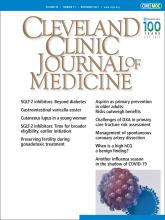Article Figures & Data
Tables
Treatment with different antiresorptive drug classes led to similar vertebral fracture reduction despite different magnitudes of change in bone density.4,5 Early fracture rate improved with risedronate therapy despite no observable bone density changes.6 High and low doses of teriparatide led to similar rates of vertebral fracture reduction but different increases in bone density.7 Large-dose sodium fluoride to treat osteoporosis led to more fractures despite increased bone density.8 A high prevalence of low-impact fractures occurred despite abnormally elevated bone mineral density in 2 patients with autosomal-dominant osteopetrosis.9 Patients with diabetes have increased fracture risk despite normal bone density.10,11 Patients with hyperparathyroidism exhibit discordance between fracture rates and central and peripheral bone density.12 Fracture risk with glucocorticoids is independent of bone mineral density and correlates better with bone microarchitecture measures.13,14 More than half of older women with incident hip fracture did not have a diagnosis of osteoporosis up to 5 years previously.15 Older age Low body weight and skeletal size Family history of osteoporosis or fractures Patient history of fractures History of falls and imbalance History of adult diseases compromising bone: endocrine disorders, bowel disease, nutritional disorders, renal disease History of use of bone-toxic drugs: glucocorticoids, antiestrogens, antiandrogens, oncology agents History of childhood disease impacting skeletal development History of pubertal problems: delayed or absent puberty, amenorrhea, anorexia nervosa History of harmful lifestyle: alcohol, tobacco, inactivity Increased bone turnover markers






